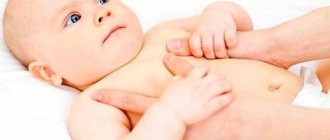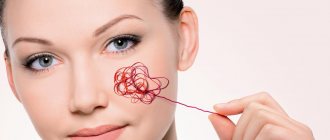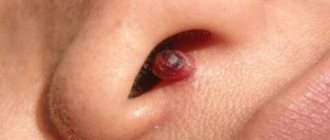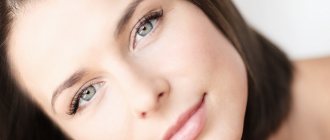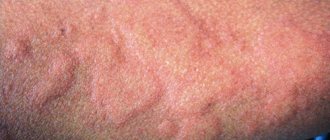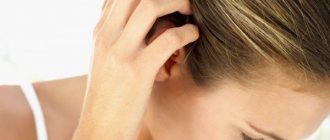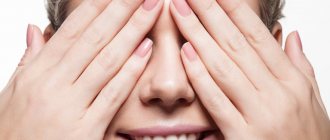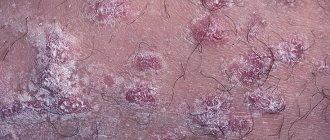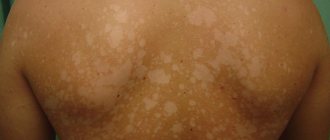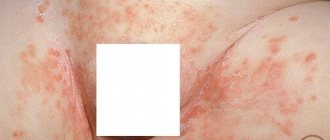Peeling skin in a child: description of the problem and causes
Periodic renewal of the upper layer of the epidermis is normal and will help your child’s skin remain soft and elastic. But if a healthy state is disrupted or environmental conditions change, this process becomes abnormal. Large areas of peeling and inflammation appear.
Why the skin on a newborn’s body may peel:
- Change of environmental conditions. In the womb, the baby's skin is protected by a special lubricant that prevents it from losing moisture. After birth, the baby's epidermis adapts to the new climate. Therefore, at first it becomes dry and begins to peel due to exposure to water and temperature. If no areas of inflammation are observed, then there is no need to worry - over time, its normal state will be restored.
- Low air humidity. In well-heated rooms, this process may occur. It is associated with insufficient saturation of the air with water vapor in the room.
In the room where the child spends most of his time, the air humidity should be between 60-65%. If there are deviations from the norm, then it is better to purchase an air humidifier, or cover the heating devices with a damp cloth and regularly carry out wet cleaning.
- Frequent use of potassium permanganate solution . Potassium permanganate dries out the skin, so you should not use it every time you bathe.
- Frequent use of shampoos, soaps and creams . Not all lines of children's shampoos are suitable for a child. When allergic reactions occur, dry skin occurs and irritated areas appear. Therefore, it is advisable to limit the use of these products and use only boiled water for daily washing.
- Prolonged exposure to the sun . Direct sunlight negatively affects the baby's epidermis. Recommended time in the sun is 30 minutes.
- Lack of vitamins in the body . If there is a lack of minerals, the skin instantly reacts to the changes that have occurred and gives a signal in the form of peeling.
- Allergy to the baby's clothes, or more precisely to their material . Synthetic fabrics and artificial dyes can negatively affect his health. Therefore, it is advisable to purchase items made from 100% cotton and with a minimum percentage of synthetic substances.
READ ALSO: What kind of terrible disease is cancerophobia and how to get rid of it
Prevention
It is easier to prevent any problem than to treat it. To avoid dry and rough skin on a child’s feet, doctors advise parents to pay attention to the following preventive recommendations:
- Take care of the child’s proper, balanced nutrition, provide his body with the necessary amount of vitamins A, B and E.
- Give your child as much fluid as possible, especially during hot periods, giving preference to clean water, milk, natural juices, and fruit drinks.
- Use natural children's cosmetics and avoid regular soap.
- Choose high-quality shoes made of genuine leather for your child that match his size.
- Avoid using socks, tights, and rompers made from synthetic materials.
Dry skin on a child’s feet is not the most serious problem, but this symptom causes the baby some discomfort and may also indicate the development of serious allergic diseases. Therefore, you should not ignore such a manifestation. Provide your baby with proper care, and if this does not help, first consult a pediatrician.
Possible diseases: symptoms, treatment
The following diseases can cause excessive peeling:
- Scabies caused by scabies mites. It manifests itself as redness, areas of peeling on the arms: in the elbow area and the area of the hands, as well as in the abdomen. The child develops severe skin itching, worsening at night. It can be eliminated by using ointments that contain sulfur, treating personal clothing and bed linen.
- Infections of fungal origin . In case of damage, characteristic rashes are observed in the groin folds and armpits, on the feet and hands. Peeling, swelling and severe burning appear, and blisters appear on the skin. Nails take on a yellowish tint. As a treatment, it is appropriate to use antifungal ointments and maintain personal hygiene.
- Ringworm, popularly called “sun fungus” . Accompanied by the appearance of dark areas covered with small scales. To eliminate this disease, antifungal drugs are used, both for external and internal use. Flucinar ointment will help with the disease.
- Skin psoriasis . Characterized by the appearance of flaky areas in the form of spots. Distributed throughout the body. Treatment depends on the cause of the disease. Medications may be prescribed to reduce the area of redness. If the disease develops against the background of nervous stress, then sedative medications are prescribed. It is imperative to combat dry skin on your hands.
- Ichthyosis or "fish disease" . On the upper layer of the epidermis, “fishy” scales of a dark gray color are formed. Locations affected: elbows, skin of hands, feet. This disease is hereditary in nature, which manifests itself before two years of life. The treatment is specific, prescribed by a doctor and lasts throughout the patient’s life.
- Atopic dermatitis . The peculiarity is massive skin rashes, often all over the body, which are accompanied by itching. The skin cracks and peels off greatly, resulting in focal inflammation of the epidermis. Due to the fact that a common cause of atopic dermatitis is diathesis, the first point in the recovery process is isolation from the source of the allergy and is accompanied by the use of antihistamines.
- Contact dermatitis . Characterized by excessive dryness of the skin in the area of the elbows and hands. The cause may be an allergic reaction to detergents and cosmetics, or to dry air. To eliminate this problem, it is worth warning the child against exposure to dry and frosty air, wearing a scarf and gloves during the cold period and less contact with shampoos and other cosmetics.
- Allergies to medications, food . Manifests itself as severe dryness and flaking of the skin. In this case, it is enough to protect the baby from the sources of the allergic reaction.
- Eczema . It manifests itself in large areas of redness of the skin throughout the body with the formation of dense scales and small blisters. Accompanied by itching, general malaise in the form of decreased appetite and irritation. To get rid of this disease, soothing baths, lotions, and creams are used.
It is important to know: to eliminate the symptoms of eczema, you must isolate the child from sources of allergies.
- Lupus erythematosus . It can be detected by bright rashes in the neck area, in the bridge of the nose and peeling. A course of hormone-based medications is prescribed.
- Pink lichen of Zhiber . Light brown to pink spots with clearly defined boundaries and protruding scales in the area of the torso, back and legs are signs of an infectious-allergic disease. Recovery will require a course of antiallergic medications.
- "Ringworm" or microsporia . It has characteristic areas of baldness on the skin of the face and neck, oval-shaped inflamed areas, the border of which is covered with small blisters and exfoliated dark-colored particles. Antifungal agents are prescribed in the form of creams, lotions and ointments.
READ ALSO: What are sexually transmitted diseases?
Atopic dermatitis
This is one of the most common causes of rough skin in a child. According to WHO, up to 15% of the world's population suffers from atopic dermatitis. Girls get sick more often than boys. The disease has a hereditary predisposition: if one of the parents has any allergies, the probability that the baby will develop atopic dermatitis is 20%; if both are allergic, the probability of the disease increases to 60%.
In essence, atopic dermatitis is an immune-dependent inflammation of the skin, during which the formation of the normal stratum corneum and lipid composition of the skin are disrupted. Speaking in Russian, due to inflammation caused by an allergic reaction, the skin produces too little fat and too many dead horn cells, which normally should protect it from external influences, but in atopic dermatitis, accumulating in excessive quantities, make the skin dry and rough.
Peeling of the scalp in newborns and adults
A common cause of this problem is seborrheic dermatitis. Significant areas of flaking occur in the hair growth area due to excessive secretion production by the sebaceous glands. If the skin on the scalp of a baby before the age of 1 year peels, this is a natural process that goes away over time without any intervention.
Attention: Under no circumstances should you touch the scales that have formed, much less try to get rid of them. This can negatively affect the health of your baby's skin. Sometimes they are lubricated with a small amount of oil for better release. When washing your baby, it is advisable to use special baby shampoos.
If seborrheic dermatitis is observed in an adult child (over 5 years old), then this process may be associated with the following reasons:
- hormonal disorders;
- problems with the functioning of the gastrointestinal tract;
- lack of vitamins;
- malfunction of the thyroid gland;
- poor nutrition;
- sudden climate change.
In such cases, the symptoms are not only the above signs, but also hair loss, dandruff, and profuse sweating. Serious treatment is required, during which several rules must be followed:
- Healthy food;
- take vitamins of various groups;
- drink enough water.
READ ALSO: Causes of bunions and methods of getting rid of them
As for the list of medications, it is strictly prescribed by a dermatologist after passing the necessary tests and examinations.
Inevitable injuries: how to remove a splinter from under a nail and from a finger without the help of a doctor.
Why nausea occurs and how to quickly cure it, find out here.
Causes and treatment of “bones” on the legs: .
Why do children have peeling facial skin?
- The main reason when the skin on a newborn’s face peels is adaptation to new environmental conditions. The main thing is to ensure that swelling and inflammation do not appear. If this does not happen, then do not worry - it will pass after 3 weeks.
- Excessive production of hormones is also manifested by peeling of the skin on the child’s cheeks. In this case, you should just wait 3-4 months, after which the hormone levels will return to normal.
- Insufficient air humidity.
- Insufficient amount of water consumed. The baby should receive a sufficient amount of drink, which can be supplemented with soups and fruit drinks.
- Frequent use of shampoos and soaps. For daily washing, it is advisable to use plain water, as well as a line of detergents designed specifically for children.
- All kinds of diseases of allergic origin.
- Lack of vitamins in the diet. The menu should include vegetables, fruits, as well as fish and meat products (depending on the age of the child).
For baby:
- Remove all objects that collect dust from the child's room, including the canopy over the crib.
- Limit all possible contacts of the baby with pets.
- Wet cleaning - daily.
- Maintain the desired level of humidity in the room (for example, by purchasing a humidifier) and ventilate it regularly.
- Bath your baby in water at 37-38 degrees, without using soap (it dries the skin). You can use herbal decoctions (as recommended by your doctor) or special moisturizing products for children.
- Use baby cream (or Bepanten) before a walk and after water treatments. Children's cosmetics, if the child's skin is prone to dryness or allergies, should be replaced with sterilized olive oil.
- Remove all synthetics from the children's closet: underwear and clothes - only from cotton fabric, clean and ironed.
- Choose a gentle washing powder for washing your baby’s clothes or use laundry/baby soap. For many toddlers, skin problems disappear immediately after mothers switch from powders to soap. Rinse the laundry thoroughly after washing.
- Do not overdry the air with air conditioners and additional heating devices.
- Change your baby's diapers in a timely manner and wash them after each “trip” to the toilet.
- Give your baby air baths more often - the body must breathe and the body must be tempered.
- Do not wrap the child in “a hundred clothes” in the apartment (and also dress the baby according to the weather outside).
And there is no need to panic. In most cases, this problem is easily solved by following the rules for caring for the little one and using Bepanten.
